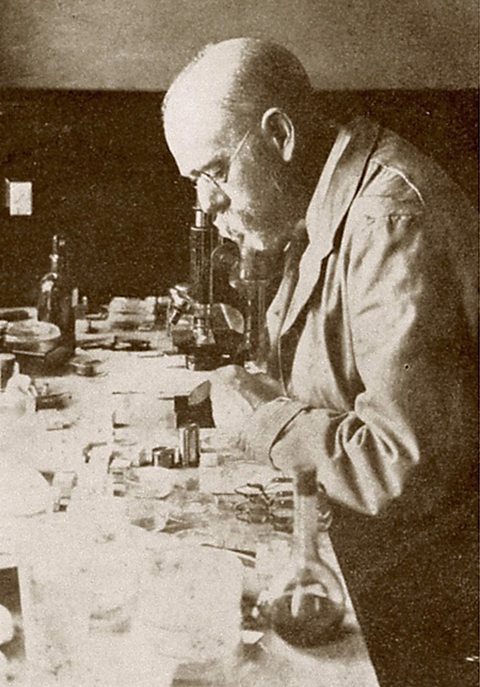Robert Koch and bacteria
In the mid-19th century, the scientist Louis Pasteur argued that bacteriaSingle-celled microorganisms, some of which are pathogenic in humans, animals and plants. Singular is bacterium. - a type of microbeMicroscopically small organism, such as a bacterium or single-celled fungus. Also called a microorganism. - was the cause of disease. However, he was not able to identify the specific bacteria which cause individual diseases. It was the German doctor Robert Koch who was able to successfully identify some of the different bacteria that cause common diseases.
Robert KochвҖҷs work on bacteria

Koch developed a new method of growing bacteria using agar jellyA gel made from algae, which provides an ideal growth medium. in a Petri dishA clear glass or plastic dish, used to grow living cells from organisms so they can be studied. He then used a dye to stain the bacteria so that it could be seen clearly under a microscopeA device used to enlarge tiny objects that cannot be seen by the naked eye. Using this method, he was able to identify individual bacteria.
In 1876, Koch found the bacteria that cause anthraxA serious disease of cattle that can transfer to humans. Then, in 1882, he identified the bacteria that cause tuberculosisA bacterial infection (also known as TB) spread through breathing in tiny droplets from the coughs or sneezes of an infected person. His discovery of the bacteria that cause choleraA bacterial infection caused by contaminated drinking water. followed shortly after, in 1883.
KochвҖҷs research inspired other scientists. Their work led to the discovery of further bacteria that cause diseases, such as diphtheria, pneumonia and meningitis. KochвҖҷs work greatly improved medicine in Britain, as doctors now understood that it was bacteria that caused the symptoms of disease, so it was the bacteria that needed to be removed.
Koch, Pasteur and the prevention of disease
KochвҖҷs identification of bacteria did not make an immediate difference to the prevention of disease. This only happened when Pasteur took KochвҖҷs work even further by developing other vaccineA substance that stimulates the body to produce antibodies to provide immunity against a disease.
Pasteur had read about Edward JennerвҖҷs smallpoxSerious illness caused by a virus. Smallpox gets its name from the pus-filled blisters (or pocks) that form during the illness. vaccine, which had been developed in the late 18th century. Now that the individual bacteria for specific diseases had been identified, Pasteur began work on developing further vaccines for animals and humans. He knew that to prevent each disease, a weakened dose of the disease was needed to build immunityWhen a person's body is not prone to a disease because they have a resistance to it.
Pasteur began developing animal vaccines for the diseases anthrax and chicken cholera. Then in 1885, he tested a human vaccine for rabies that saved a boyвҖҷs life after he had been bitten by a dog. This was the first successful vaccine since JennerвҖҷs smallpox vaccine.